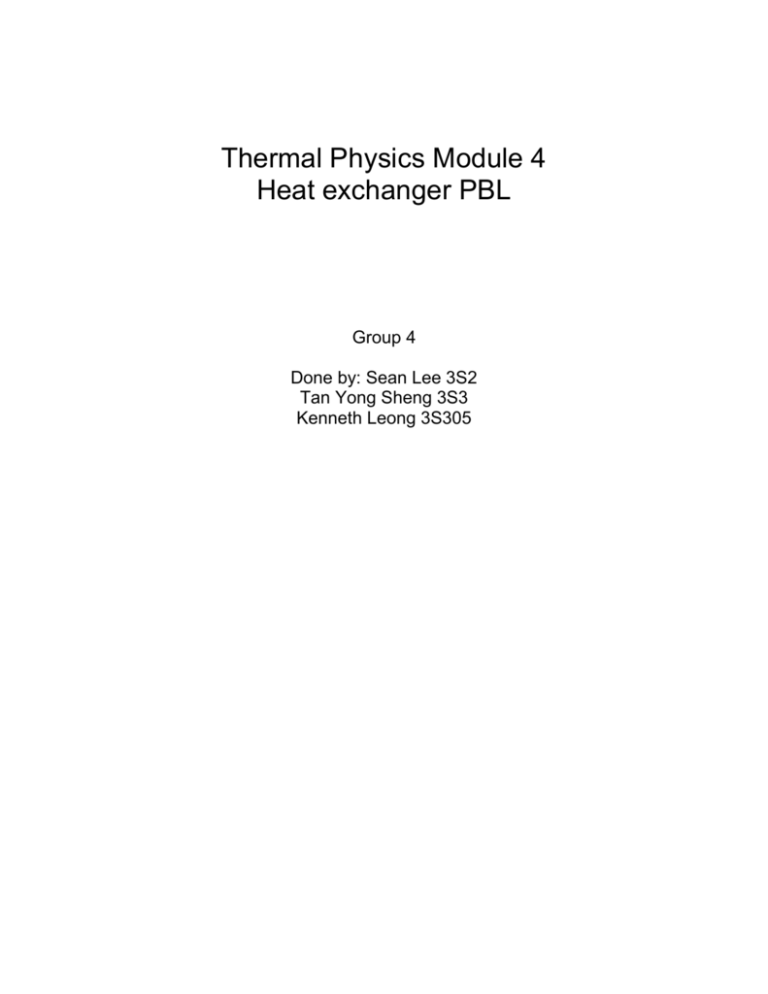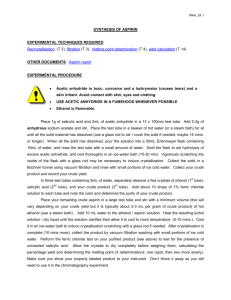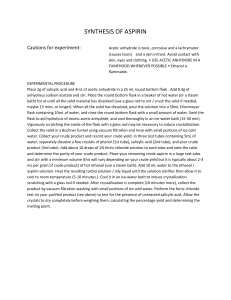thermal physics project based learning effective
advertisement

Thermal Physics Module 4 Heat exchanger PBL Group 4 Done by: Sean Lee 3S2 Tan Yong Sheng 3S3 Kenneth Leong 3S305 Conversions of the Specifications and informations Mass flow rate = 30000 lb/h = 226,796.185 g/min Crude oil to be heated from 70 F to 136 F = 21.11°C to 57.78°C Product to be cooled from 295 F to 225 F = 146.11°C to 107.22°C Properties of crude oil heat capacity = 0.475 BTU/lbF = 1.98873 J/g°C viscosity = 2.9 mPa.s = 2.9 cP thermal conductivity = 0.0789 BTU/ft.h.F density = 51.5 lb/ft³ = 0.82495086026 g/cm³ Properties of Product heat capacity = 0.525 BTU/lbF = 2.19807 J/g°C viscosity = 5.2 mPa.s = 5.2 cP thermal conductivity = 0.069 BTU/ft.h.F density = 54.1 lb/ft³ = 0.86659886485 g/cm³ Specifications of heat exchanger Type: Shell and tube - one pass on the shell side, two passes on the tube side Shell diameter: 23.25 in = 59.055 cm No. of tubes: 324 Type of tubes: BWG 14 arranged on a 1 inch square patch, supported by baffles Length of tubes: 12 ft = 365.76 cm Outer diameter of tubes: 0.75 in = 1.905 cm Baffles: 25% cut spaced at 22.86 cm intervals. Inner diameter: 0.584 in = 1.48336 cm Thickness of tube wall: 0.083 in = 0.21082 cm ______________________________________________________________________________________ Taking Crude oil in shell, product in tube If we take the product to be in the tube and the crude oil in the shell, then several things cannot be calculated. This is because the mass flow rate of the product is not given, hence we cannot find the velocity of the product and hence important information such as the heat transfer coefficient cannot be found. This can be proven further in the rough calculation below. Assumption that heat transfer efficiency is at 100%, as the heat transfer efficiency cannot be calculated. Diameter of shell = 1.9375 ft area of shell = 2.9483 ft^2 volume of shell = 35.3793ft^3 volume when minus volume of tubes = 28.14735159 ft^3 Hence, the volume of the crude oil in the shell is 28.14735159 ft^3 Using the volume and density, we can calculate the mass of crude oil in the shell Mass of oil in the shell = 1,449.588607 lb = 657522.3323g Heat energy needed for oil to gain 66F = 5,899,436.483 calories(using specific heat capacity which is using the mass x 60F x 0.475) Mass of product = 177477.109G heat energy released by product to reduce 70 F = 1,967,057.958 calories Hence from the above calculation, the energy released by the product is not enough to heat up the oil, so, by putting the product in the tube, and with the limited information on the product, this heat exchanger is not workable if we put the crude oil in shell and product in tube. ______________________________________________________________________________________ Crude oil in tube, product in shell Having proven that putting the crude oil in shell and product in tube is not workable, we will now try to put the crude oil in the tube. Doing by the same method as the above, Now,if we try to put oil into pipe then, Mass of oil in pipe = 182,025.7913g Heat energy needed for oil to gain 66F = 1,633,175.85 Mass of product in shell = 690,717.6345g Heat energy lost for product to lose 70 F = 7,655,453.782 Therefore, energy lost by the product is enough to heat up the crude oil. This will be further shown by the following calculations. Surface area of tubes = 1.905 365.76 324 = 709228.3243 cm² Volumetric flow rate = mass flow rate/ density = 226796.185/ 0.82495086026 = 274920.8419 cm³/min = 72.626403042 US gallon/min Velocity = 0.4085 volume flow / pipe inside diameter2 = 0.4085 x 72.626403042 / 0.5842 = 86.98831172 ft/s = 159084.22447354 cm/min Reynolds number = (density x velocity x diameter)/viscosity = 0.82495086026 g/cm³ x 84.22447354 cm/min x 1.905 cm = 112000 http://www.efunda.com/formulae/fluids/calc_reynolds.cfm#calc Since Reynolds number > 4000, flow of crude oil is turbulent. Therefore, the flow in the pipe is good. Volume of crude oil = (1.48336 2) = 204797.3005 cm³ 2 365.76 324 Area of circle Volume of 1 tube Having known the volume, we can now calculate the mass Mass of crude oil = volume x density = 204797.3005 x 0.82495086026 = 168947.7092 g 365.76 cm Heat energy to be gained by crude oil to increase from 70°F to 136°F (21.11 °C to 57.78°C) = Specific heat capacity x Mass of Crude oil x (Temperature of end result – initial result) = 1.98873 x 168947.7092 x (57.78- 21.11) = 1.98873 x 168947.7092 x 36.67 = 1229728493 J Time taken for crude oil to flow through 324 pipes = distance / velocity = = 0.275899143 min Heat transfer coefficient = Energy / time taken x surface area for heat transfer x difference in temperature = = 171.396276 Log mean temperature difference = (146.11 - 21.11) - (107.22 - 57.78) (146.11 - 21.11) ln (107.22 - 57.78) = 81.46467451°C Rate of heat transfer = Heat transfer coefficient x heat transfer surface area x LMTD = = 9902771995 J/sec = 1650461999 J/min Effectiveness formula = = 29.27412658 Ratio between the actual heat energy transferred to the maximum possible heat energy that can be transferred ≈ 29:1 (Effective) Since the effectiveness is more than 1.0, we can conclude that the heat exchanger is effective.





